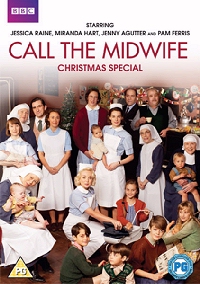
Call the Midwife Christmas Special Focuses on Relinquishment and Adoption
In this holiday special, Jennifer Lee Worth, who was the author of the books, is portrayed as an older woman, remembering Christmas of 1959, which is the setting for the rest of the episode. There are several story lines, which come together as the program progresses. One concerns “mother and baby homes,” the British version of unwed mothers’ homes. The one in the episode has been touted as “well-run, a home away from home, where the girls are treated well.” In fact, the place is dirty, the babies are neglected for the most part, the matron is hostile and unfeeling, refuses to seek adequate medical help for the residents, and puts gin in her hot milk! In addition to the inadequate or inappropriate medical care, there are plenty of lies, and babies are taken from their mothers without permission, generally at six weeks, not three years as seen in Philomena, although some details are similar. The truth comes out, along with some unexpected developments and decisions. One girl’s mother says she hopes her daughter can “make a fresh start” and “not make the same mistake again,” phrases many birth mothers have heard when family or others were urging them to relinquish. Another young woman acts very haughty and uncaring, says she doesn’t want to see “it,” or have any reminders, just wants to go to the hospital and “be done with it.” She smokes constantly, which, in fact, many pregnant women did in those days, and were never discouraged from it. When this young woman sees what is really happening at this “home,” she calls the nurses at Nonatus House and tells them. The doctor who is their medical director, and now father of an adopted baby, gets rid of the alcoholic matron and literally cleans house, so the nurse-midwives are there round the clock over Christmas, at which time the previously haughty young woman gives birth during a blizzard, unable to get to any hospital. The rest of her story will surprise the viewer, as she reveals her own history.
This program subtly presents birth mothers’ and adoptive parents’ viewpoints, with great respect for birth mothers. It is a poignant gift for triad members of all sorts, as well as those who wish they could have been parents. In addition to the mother and baby homes story line, there is a couple who were formerly in a mental institution and while there, the woman was sterilized without her permission or knowledge, and also given a lobotomy. The man, who met her there, has a seizure disorder, which, although not mentioned in the program, often resulted in sterilization, also. The couple believes she is pregnant, not knowing of her past tubal ligation, and are quite devastated to learn the truth. This situation is handled with great compassion by the nurse and doctor, and there are statements about the inadequacy and cruelty of mental health treatment at that time. Again, what is portrayed is similar to the state of mental health treatment in the U.S. at that time, and even later.
One of the details of the “mother and baby home” portrayed is that the matron hands out so-called wedding bands to the “girls” if they go outside, including to the hospital to give birth. This really was the policy at many such places in the States. It was said to “save them from embarrassment,” but didn’t fool anyone.
After this particular young woman gives birth, she has a gradual transformation and the nurse tells her, “There’s no law that says you can’t keep her.” Socially, of course, the pressure was as powerful as a law for many birth mothers. The doctor and his wife (a former nun) write a letter to the birth mother of their adopted baby girl, hoping the agency will pass it on, but admitting that they don’t know if that will happen. Again, they express their concern for the birth mother and her feelings. While viewers who are birth mothers may never have received such a letter, most wish that they had, and will find that part especially moving.
The program ends with Jennifer Lee Worth and her husband discussing the possibility of her writing her memoirs about being a nurse midwife, which of course she did. Her books are available through Amazon and possibly through Edward R. Hamilton Bookseller Co., which puts out a mail order catalogue called Bargain Books, which is where I obtained the second two volumes. As for the series and this particular holiday special, they can be viewed online at http://video.pbs.org/program/call-midwife/. If you saw it on television on December 28, 2014, you may want to see it again. You will catch more subtle details and appreciate how beautifully it’s done when you see it again. It would also be a great film for a support group to watch and discuss.
Excerpted from the January 2015 edition of the Operation Identity Newsletter
© 2015 Operation Identity